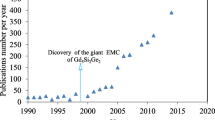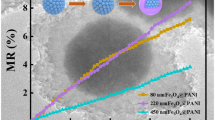Abstracts
The magnetocaloric effect (MCE) has made great success in very low temperature refrigeration, which is highly desirable for application to the extended higher temperature range. Here we report the giant enhancement of MCE in the metallic glass composite. The large magnetic refrigerant capacity (RC) up to 103 J·kg−1 is more than double the RC of the well-known crystalline magnetic refrigerant compound Gd5Si2Ge1.9Fe0.1 (357 J·kg−1) and MnFeP0.45As0.55 (390 J·kg−1)(containing either exorbitant-cost Ge or poisonous As). The full width at half maximum of the magnetic entropy change (ΔS m) peak almost spreads over the whole low-temperature range (from 303 to 30 K), which is five times wider than that of the Gd5Si2Ge1.9Fe0.1 and pure Gd. The maximum ΔSm approaches a nearly constant value in a wide temperature span over 100 K, and however, such a broad table-like region near room temperature has seldom been found in alloys and compounds. In combination with the intrinsic amorphous nature, the metallic glass composite may be potential for the ideal Ericsson-cycle magnetic refrigeration over a broad temperature range near room temperature.
Similar content being viewed by others
References
Krenke T, Duman E, Acet M, et al. Inverse magnetocaloric effect in ferromagnetic Ni-Mn-Sn alloys. Nat Mater, 2005, 4: 450–454
Provenzano V, Shapiro A J, Shull R D. Reduction of hysteresis losses in the magnetic refrigerant Gd5Ge2Si2 by the addition of iron. Nature, 2004, 429: 853–857
Tegus O, Bruck E, Buschow K, et al. Transition-metal-based magnetic refrigerants for room-temperature applications. Nature, 2002, 415: 150–152
Pecharsky V K, Gscheidner K A Jr. The giant magnetocaloric effect in Gd5(Ge2Si2). Phys Rev Lett, 1997, 78: 4494–4497
Korte B J, Pecharsky V K, Gschneidner K A Jr. The correlation of the magnetic properties and the magnetocaloric effect in (Gd1−x Erx)NiAl alloys. J Appl Phys, 1998, 84: 5677–5685
Hashimoto T, Kuzuhara T, Matsumoto K, et al. A new method of producing the magnetic refrigerant suitable for the Ericsson magnetic refrigeration. IEEE Trans Mag, 1987, 23: 2847–2849
Gomesa A M, Proveti J R, Takeuchi A Y, et al. La(Fe1−x Cox)11.44Al1.56: A composite system for Ericsson-cycle-based magnetic refrigerators. J Appl Phys, 2006, 99: 116107
Luo Q, Zhao D Q, Pan M X, et al. Magnetocaloric effect of Ho-, Dy-, and Er-based bulk metallic glasses in helium and hydrogen liquefaction temperature range. Appl Phys Lett, 2007, 90: 211903
Hashimoto T, Kuzuhura T, Sahashi M, et al. New application of complex magnetic materials to the magnetic refrigerant in an Ericsson magnetic refrigerator. J Appl Phys, 1987, 62: 3873–3878
Smaili A, Chahine R. Composite materials for Ericsson-like magnetic refrigeration cycle. J Appl Phys, 1997, 81: 824–829
Shao Y Z, Zhang J X, et al. Magnetic entropy in nanocomposite binary gadolinium alloys. J Appl Phys, 1996, 80: 76–80
Wang D H, Han Z D, Huang S L, et al. The low-field magnetic entropy change in melt-spun and annealed Gd ribbons. Physica B, 2004, 352: 185–189
Hou X L. Research on magnetocaloric effect of GdAl alloy. Rare Metal Mater Engin, 2006, 35: 749–751
Zhang T B. The structure and magnetocaloric effect of rapidly quenched Gd5Si2Ge2 alloy with low-purity gadolinium. Mater Lett, 2007, 61: 440–443
Luo Q, Zhao D Q, Pan M X, et al. Magnetocalroric effect in Gd-based bulk metallic glass. Appl Phys Lett, 2006, 89: 081914
Kong H Z, Ding J, Dong Z J, et al. Observation of clusters in Re60Fe30Al10 alloys and the associated magnetic properties. J Phys D, 2002, 35: 423–429
Wang W H. Correlations between elastic moduli and propertyes in bulk metallic glasses. J Appl Phys, 2006, 99: 093506
Shen T D, Schwarz R B, Coulter J Y, et al. Magnetocaloric effect in bulk amorphous Pd40Ni22.5Fe17.5P20 alloy. J Appl Phys, 2002, 91: 5240–5245
Yavari A R. The changing faces of disorder. Nat Mater, 2007, 6: 181–182
Greer A L. Metallic glasses. Science, 1995, 267: 1947–1953
Yano K, Akiyama Y, Tokumitsu K, et al. Magnetic moment and Curie temperature for amorphous Fe100−X GdX alloys. J Mag Mag Mater, 2000, 214: 217–224
Chen D, Takeuchi A, Inoue A. Thermal stability and magnetic properties of Gd-Fe-Al bulk amorphous alloys. J Alloys Comp, 2007, 440: 199–203
Yoshiike S, Adachi H, Ichinose H, et al. Structure of melt-quenched Pr-Fe alloys and analysis of the magnetization based on super-ferromagnetism. JIM, 1998, 39: 102–109
Xiong D K, Li D, Liu W, et al. Magnetocaloric effect of Gd(FexAl1−x )2 compounds. Physica B, 2005, 369: 273–277
Singh N K, Suresh K G, Nirmala R, et al. Correlation between magnetism and magnetocaloric effect in the intermetallic compound DyNiAl. J Appl Phys, 2006, 99: 08K904
Johnson F, Shull R D. Amorphous FeCoCrZrB ferromagnets for use as high-temperature magnetic refrigerants. J Appl Phys, 2006, 99: 08K909
Kolat V S, Atalay S. Magnetocaloric behavior in Fe57Cr17Cu1Nb3Si13B9 soft magnetic alloys. Phys Stat Sol, 2004, 1: 3529–3532
Fujieda S, Fujita A, Fukamichi K. Large magnetocaloric effect in La(FexSi1−x )13 itinerant-electron metamagnetic compounds. Appl Phys Lett, 2002, 81: 1276–1278
Phan M H, Yu S C. Review of the magnetocaloric effect in manganite materials. J Mag Mag Mater, 2007, 308: 325–340
Stadler S, Khan M, Mitchell J, et al. Magnetocaloric properties of Ni2Mn1−x CuxGa. Appl Phys Lett, 2006, 88: 192511
Provenzano V, Shapiro A J, Shull R D, et al. Peak magnetocaloric effects in Al-Gd-Fe alloys. J Appl Phys, 2004, 95: 6909–6911
McMichael R D, Ritter J J, Shull R D. Enhanced magnetocaloric effect in Gd3Ga5−x FexO12. J Appl Phys, 1993, 73: 6946–6948
Yan A, Müller K H, Schultz L, et al. Magnetic entropy change in melt-spun MnFePGe. J Appl Phys, 2006, 99: 08K903
McMichael R D, Shull R D, Swartzendurber L J, et al. Magnetocaloric effect in superparamagnets. J Mag Mag Mater, 1992, 111: 29–33
Nirmala R, Morozkin A V, Malik S K, et al. Magnetocaloric effect in the intermetallic compound Gd5Si2Sb2. Europhys Lett, 2005, 72: 652–657
Author information
Authors and Affiliations
Corresponding author
Additional information
Supported by the National Natural Science Foundation of China (grant Nos. 50621061 and 50731008) and the National Basic Research Program of China (973 Program) (Grant No. 2007CB613904)
Rights and permissions
About this article
Cite this article
Wang, Y., Bai, H., Pan, M. et al. Giant enhancement of magnetocaloric effect in metallic glass matrix composite. Sci. China Ser. G-Phys. Mech. As 51, 337–348 (2008). https://doi.org/10.1007/s11433-008-0053-2
Received:
Accepted:
Published:
Issue Date:
DOI: https://doi.org/10.1007/s11433-008-0053-2




